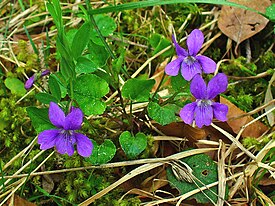Βιολέτα
| Βιολέτα | ||||||||||||
|---|---|---|---|---|---|---|---|---|---|---|---|---|
 Βιολέτα
| ||||||||||||
| Συστηματική ταξινόμηση | ||||||||||||
| ||||||||||||
| Είδη | ||||||||||||
|
Περίπου 500 είδη. | ||||||||||||
Η βιολέτα ή ο μενεξές ή το ίο είναι κοινή ονομασία πολλών ειδών φυτών του γένους Ίον (Viola) της οικογένειας των Ιοειδών. Με την ονομασία βιολέτα έχουν περιγραφεί και ταξινομηθεί 500 είδη.
Ετυμολογία
[Επεξεργασία | επεξεργασία κώδικα]Η ετυμολογία της λέξης «βιολέτα» προέρχεται από το υποκοριστικό του ιταλικού viola [1] που είναι και η ομώνυμη επιστημονική ονομασία του γένους στα λατινικά, ενώ η ετυμολογία της λέξης «μενεξές» προέρχεται από το τουρκικό menekşe, το οποίο είναι περσικής προέλευσης.[2] Η λέξη «ίο» προέρχεται από τη λέξη της αρχαίας ελληνικής ἴον.
Περιγραφή
[Επεξεργασία | επεξεργασία κώδικα]Είναι μονοετή ή πολυετή ποώδη φυτά ή σπάνια μικροί θάμνοι. Στις περισσότερες περιπτώσεις δεν έχουν βλαστό ή είναι αποξυλωμένος στη βάση. Τα φύλλα είναι συνήθως απλά, έχουν πάντα παράφυλλα και αναπτύσσονται κατ' εναλλαγή στα είδη με βλαστό ή είναι παράρριζα στα είδη χωρίς βλαστό. Τα άνθη φύονται μοναχικά σε ψηλούς ποδίσκους και είναι συνήθως μωβ, μπλε, άσπρα, κίτρινα και βαθυκόκκινα. Έχουν πέντε πέταλα, εκ των οποίων τα τέσσερα διατάσσονται σε δύο ανόμοια ζεύγη, ενώ το πέμπτο πρόσθιο και κατώτερο είναι διαμορφωμένο στη βάση του σε σακκοειδή αιχμηρή προσβολή στην οποία εισχωρούν δύο νεκταριογόνες αποφυάδες των δύο πρόσθιων στημόνων. Αρκετές από τις βιολέτες έχουν δύο τύπους άνθεων, έναν γόνιμο και έναν στείρο. Τα χειμερινά ή ανοιξιάτικα άνθη είναι φανταχτερά, με μεγάλα ωραία πέταλα, και είναι συνήθως στείρα. Τα θερινά άνθη είναι μικροσκοπικά με δυσδιάκριτα ή καθόλου πέταλα, τελείως κλειστά και αυτογονιμοποιούμενα.
Τα γόνιμα άνθη εξασφαλίζουν την αύξηση του πληθυσμού. Φύονται συνήθως σε λιβάδια ή υγρά δάση. Γενικά αναπτύσσονται καλύτερα στην υγρασία και τη σκιά.
Είδη
[Επεξεργασία | επεξεργασία κώδικα]Οι βιολέτες δημιουργούν πολλά υβρίδια στη φύση, γεγονός που δυσκολεύει στην αναγνώριση του είδους τους. Επίσης ο άνθρωπος με τη διαδικασία της τεχνητής επιλογής έχει δημιουργήσει πολλές ποικιλίες και υβρίδια. Τα περισσότερο καλλιεργούμενα είδη διεθνώς είναι:[3]

- V. canina - Βιόλα η σκυλίσια, βιολέτα ρείκι, του σκύλου.
- V. corsica - Βιόλα η κορσικανική, βιολέτα της Κορσικής.
- V. labradorica - Βιόλα του Λαμπραντόρ, η βιολέτα των Άλπεων.
- V. odorata - Βιόλα η εύοσμη, η γλυκιά βιολέτα, είναι πόα χωρίς βλαστό με μακριές ριζοβολούσες παραφυάδες και καρπό χνουδωτή κάψα. Τυπική βιολέτα της αγγλικής και ελληνικής υπαίθρου.
- V. persicifolia - Βιόλα η περσικόφυλλος, βιολέτα του βάλτου.
- V. riviniana - Βιόλα η ριβινιανή, βιολέτα του σκύλου.
Και στην Ελλάδα είναι διαδεδομένες οι:
- V. alba - Βιόλα η λευκή πολύμορφο ποώδες τριχωτό είδος, με αρωματικά άνθη λευκά ή ανοιχτά μωβ.
- V. cretica - Βιόλα η κρητική, πόα χωρίς βλαστό, είδος ενδημικό της αλπικής ζώνης των βουνών της Κρήτης.
- V. delphinantha - Βιόλα η δελφινανθής, πολυετές ημιθαμνώδες πολύβλαστο είδος με μεγάλο σπηρούνι. Απαντά σε άγονες βραχώδεις περιοχές των βουνών της Βόρειας Ελλάδας.
- V. fragrans - Βιόλα η ευώδης, πολυετής τριχωτή πόα, με φύλλα επιμήκη και μαύρα. Τα άνθη είναι μεγάλα, κίτρινα και ασθενώς μωβ.
- V. hymettia - Βιόλα του Υμηττού, μονοετές, ποώδες φουντωτό είδος με κοντό τρίχωμα. Τα άνθη του είναι συνήθως κιτρινωπά.
- V. poetica - Βιόλα η ποιητική, πολυετής άτριχη πόα, με μωβ ή μπλε άνθη.
Επιπλέον, στην Ελλάδα συναντάται η Βιόλα του Στογιάνοφ (Viola stojanowii). Είναι ένας μικρός κίτρινος αγριοπανσές, που πήρε το όνομά του από τον γνωστό Βούλγαρο βοτανολόγο Νικολάι Στογιάνοφ, συγγραφέα του έργου Η χλωρίδα της Βουλγαρίας. Είναι φυτό ενδημικό στις κορυφές του όρους Μπέλλες, νανώδες, πολυετές, με φύλλα μικρά, ποώδη και άνθη κίτρινα. Ανθίζει τον Ιούνιο-Ιούλιο.
Χρήσεις
[Επεξεργασία | επεξεργασία κώδικα]Οι βιολέτες καλλιεργούνται κυρίως ως καλλωπιστικά φυτά σε κήπους ενώ είναι ιδανικές για γλάστρες, ζαρντινιέρες και τοποθέτηση σε βάζα με νερό. Από τα άνθη και τα φύλλα τους παραλαμβάνεται αιθέριο έλαιο που περιέχει λιπαρά οξέα με χαλαρωτικές, αντιφλεγμονώδεις, και καταπραϋντικές ιδιότητες. Το αιθέριο έλαιο της βιολέτας είναι κατάλληλο για ευαίσθητα δέρματα και για την εξάλειψη κηλίδων και λεκέδων. Οι βιολέτες χρησιμοποιούνται στην αρωματοποιία λόγω του ιδιαίτερα έντονου αρώματός τους. Επίσης χρησιμοποιούνται για στολισμό σε διάφορες τελετές κοινωνικού χαρακτήρα. Από το χρώμα συγκεκριμένων ποικιλιών ετυμολογείται και η λέξη βιολετί που σημαίνει το ιώδες χρώμα (δηλ. αυτό που μοιάζει με ίον).
Χρήση ως τρόφιμο
[Επεξεργασία | επεξεργασία κώδικα]Οι άγριες βιολέτες χρησιμοποιούνται και ως τροφή. Τρώγονται ωμές σε σαλάτες ή μαγειρεύονται ως αρωματικό υλικό συνταγών. Στη ζαχαροπλαστική χρησιμοποιούνται για την παρασκευή γλυκών, σιροπιών και καραμέλας.
Δείτε επίσης
[Επεξεργασία | επεξεργασία κώδικα]Πηγές
[Επεξεργασία | επεξεργασία κώδικα]- Εγκυκλοπαίδεια Πάπυρος Λαρούς Μπριτάννικα, τόμος 14, σελίδα 302.
- Λεξικό της Νέας Ελληνικής Γλώσσας του Γ. Μπαμπινιώτη. ISBN 960-86190-1-7
Παραπομπές
[Επεξεργασία | επεξεργασία κώδικα]- ↑ Λεξικό Τριανταφυλλίδη @ Πύλη για την Ελληνική Γλώσσα (ετυμολογία της λέξης «βιολέτα»),
- ↑ Λεξικό Τριανταφυλλίδη @ Πύλη για την Ελληνική Γλώσσα (ετυμολογία της λέξης «μενεξές»)
- ↑ «American Violet society (Ανάλυση ποικιλιών στα αγγλικά)». Αρχειοθετήθηκε από το πρωτότυπο στις 7 Ιανουαρίου 2010. Ανακτήθηκε στις 24 Σεπτεμβρίου 2011.
Εξωτερικοί σύνδεσμοι
[Επεξεργασία | επεξεργασία κώδικα] Πολυμέσα σχετικά με το θέμα Viola (Violaceae) στο Wikimedia Commons
Πολυμέσα σχετικά με το θέμα Viola (Violaceae) στο Wikimedia Commons Λεξιλογικός ορισμός του βιολέτα στο Βικιλεξικό
Λεξιλογικός ορισμός του βιολέτα στο Βικιλεξικό
|
